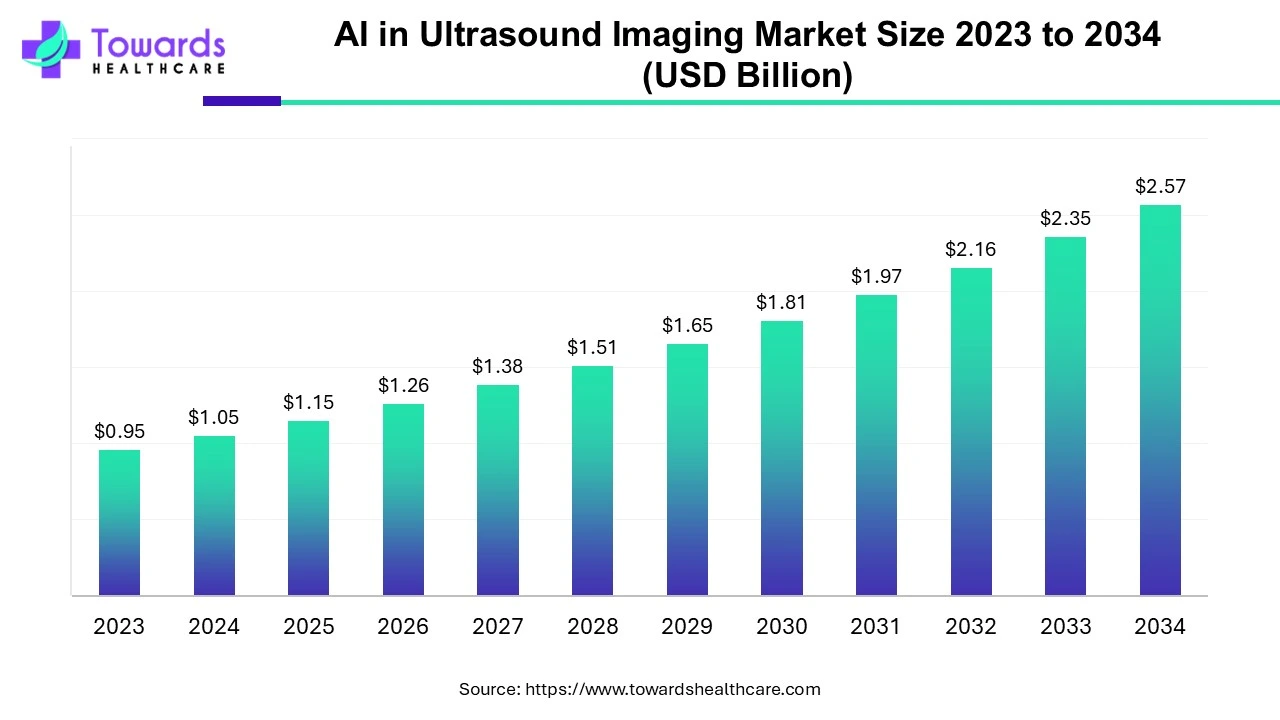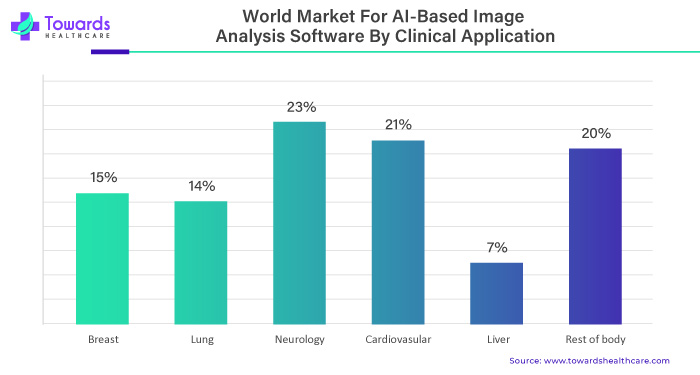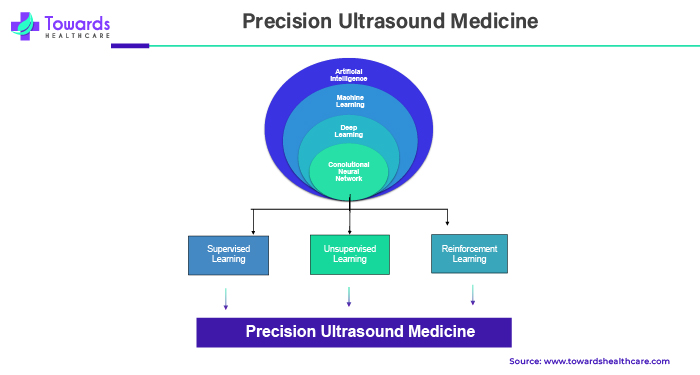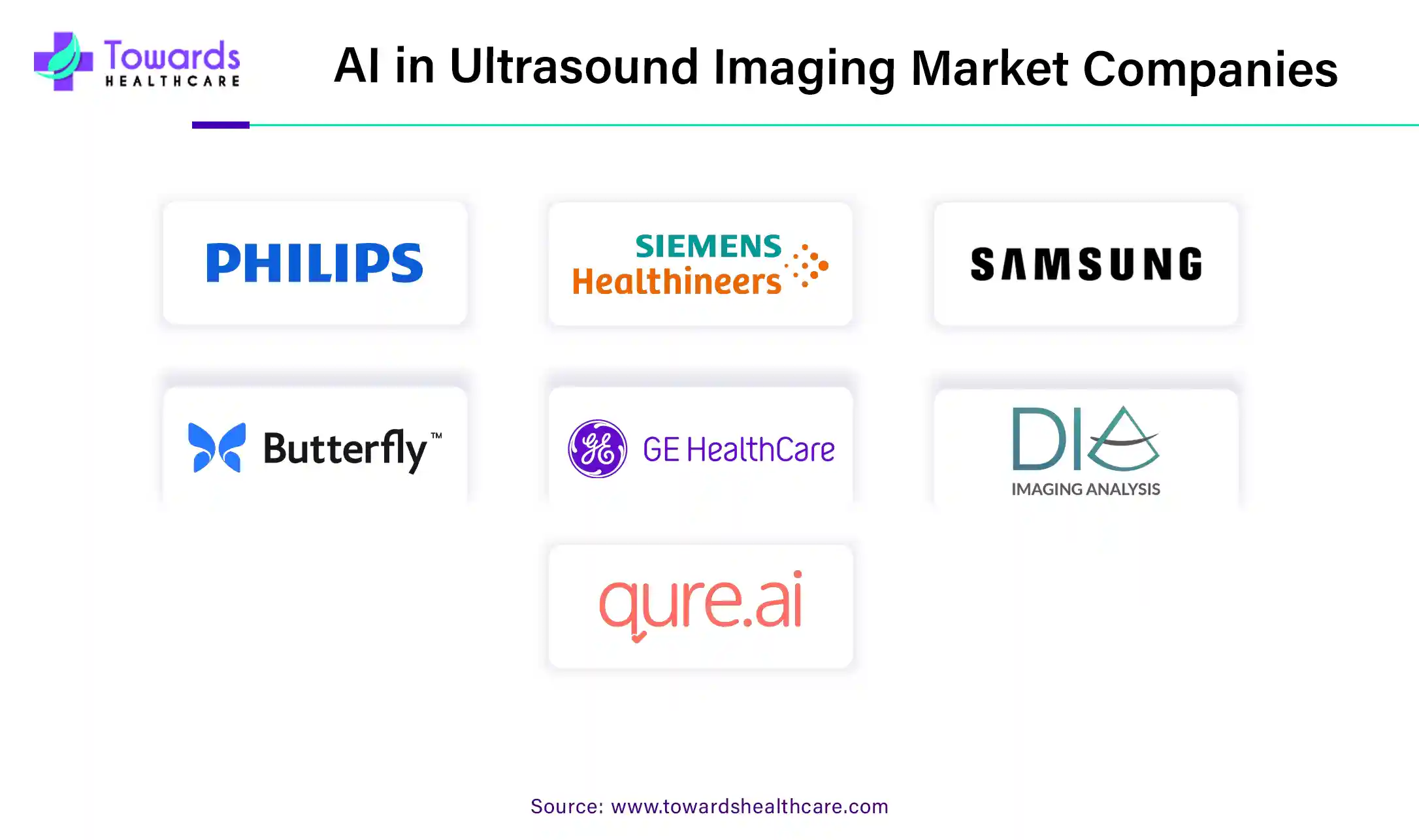December 2025

The global AI in ultrasound imaging market size is projected to reach USD 2.6 billion by 2035, expanding from USD 1.14 billion in 2025, at an annual growth rate of 8.6% during the forecast period from 2026 to 2035, as a result of the increasing prevalence of several chronic and lifestyle disorders.

| Key Elements | Scope |
| Market Size in 2026 | USD 1.24 Billion |
| Projected Market Size in 2035 | USD 2.6 Billion |
| CAGR (2026 - 2035) | 8.6% |
| Leading Region | North America |
| Market Segmentation | By Solution, By Application, By Ultrasound Technology, By End User, By Geography |
| Top Key Players | Philips, Siemens Healthineers, Samsung Healthcare, Butterfly Network, In, GE HealthCare, DiA Imaging Analysis, Qure.ai, Exo Imaging, Inc, Ultrasound Al Inc |
The Impact of Advanced 3D and Real-time 4D on Surgical Precision and Fetal Health, due to these Transformative Technologies Sets a New Benchmark in Healthcare Innovation and Driving Demand for Enhanced Imaging Solution Worldwide.
Diagnostic ultrasound is non-invasive imaging technique using transducer that emit high-frequency sound waves that frequency above the threshold of human earing. most of diagnostic probe is to be place in the skin, they can also be inserted in the internally through Gastrointestinal tract, Vagina, or Blood Vessels for the better image quality. In surgery sterile probe can used. Artificial Intelligence in Ultrasound Imaging potentially elevate the use of medical Ultrasound Imaging with broad uses in clinical setting. the main application of Artificial Intelligence in Ultrasound Imaging is to Assist Physician for the diagnosis and triage the patient.
Ultrasound (US), a Flexible Green Imaging Modality, is expanding Globally as 1st line Imaging technique in clinical field following with High performing Ultrasound-AI.
Components of AI-based Ultrasound Imaging System:
The global market for Artificial Intelligence in Imaging has witnessed a significant growth in recent years. AI technologies are increasingly integrated into ultrasound system to enhance image quality, diagnostic accuracy, and workflow efficiency. These advancements aim to assist healthcare professionals in interpreting ultrasound scan, detecting abnormalities, and improving overall patient care. The integration of AI Algorithms holds promise for faster and more precise diagnostic, contributing to the expansion of the ultrasound imaging market on a global scale.
For Instance,
Cardiovascular diseases and digestive disorders are on the rise globally. According to WHO, Heart Attack and Stroke account for 85% of Worldwide deaths. Because of this prevalence, diseases necessitate faster and more accurate diagnostic procedures. Due to the global prevalence rate of diseases, Hospitals and Clinics are facing an increasing need for advanced Artificial Intelligence Ultrasound Imaging to cope with rising diseases.
AI-ultrasound imaging is crucial medical equipment for early detection; it facilitates faster and more efficient diagnosis. The demand for AI in Ultrasound Imaging is growing to meet escalating requirements for improved medical imaging solutions early detection through AI-enhanced ultrasound Imaging in Timely and effective medical intervention. AI in ultrasound imaging works as an intelligent helper for doctors; it helps them find problems faster, especially in cardiovascular diseases, digestive disorders, and obstructive and gynaecology. Due to this, the demand for AI in Ultrasound imaging is increasing. It's not about just finding the problems. It's about treating the issue sooner, which is very important for dealing with Global prevalence.
AI applications in ultrasound have revolutionized medical imaging, providing navigation and automated quantification tools for analyzing diverse areas such as the breast, prostate, liver, heart, and obstetric/gynaecological domains. In obstetrics, AI facilitates workload management by automatically detecting standard planes, ensuring quality assurance in fetal ultrasound. Moreover, it aids in gynaecological assessments by automatically detecting endometrial thickness and classifying ovarian cysts. AI contributes to precise cardiac evaluations, vessel characterization, liver imaging, and pathology detection in cardiovascular and gastroenterology ultrasound. This technology enhances diagnostic capabilities and drives the global AI Ultrasound Imaging market's growth, offering advanced solutions for pregnancy monitoring and expanding its reach across diverse medical fields.

Ultrasonography stands out for its convenience, low cost, real-time capabilities, and non-invasive nature, making it the most widely used imaging modality. Antenatal ultrasound (US) examinations play a pivotal role in assessing fetal growth and detecting birth defects, enabling timely and effective interventions. The potential for reducing severe birth defects through the timely termination of pregnancies with poor prognoses underscores the significance of this process.
Research in radiology with AI has flourished with a particular focus on AI-assisted diagnosis in the field of ultrasound. Noteworthy successes have been achieved in the intelligent diagnosis of liver, thyroid, and breast diseases. Despite these breakthroughs in measurement, imaging, and diagnosis, the application of AI in prenatal ultrasound diagnosis remains in its early stages. The integration of AI in prenatal ultrasound not only enhances efficiency but also addresses the inexperience and skill gaps among examiners.
This is particularly crucial given the time-sensitive nature of antenatal care. Importantly, as the global market for ultrasound technology expands, driven by advancements in AI applications, the reach and impact of these technologies are poised to play a pivotal role in shaping the future of prenatal diagnostics. In this review, we delve into recent literature on the application of AI in prenatal ultrasound diagnosis, recognizing its evolving role in the broader landscape of healthcare.
| AI Application | Description | Clinical Utility |
| Fetal Biometric Plane Finder | Standard fetal biometric planes are automatically acquired, measured and stored | Reduce repetitive caliper adjustment clicks; reduce operator bias; instant quality control |
| Probe Guidance | Operator is guided how to manipulate probe to acquire fetal biometric plane | Facilitate sonographer training; basic scanning can be performed by non-expert (e.g. general practitioner) |
| Anomaly Highlighting | Unusual fetal findings are identified in a standard plane | Highlight suspected abnormal finding; assist sonographer with referral decision Improve consistency; reduce likelihood of error |
| Anomaly Scan Completeness | Anomaly scan checklist of mandatory planes is populated automatically | Ensure completeness of imaging and that all parts of anatomy are checked |
| Lung Scans for Ob/Gyn | Ob/Gyn experts are taught how to perform lung ultrasound in patients with COVID19 | Reduce learning curve |
The ability of a computer program to carry out tasks related to cognitive abilities, such as reasoning, learning, modification, sensory understanding, and interaction, is known as artificial intelligence, or AI.is a well-known innovator in the medical field that has already contributed to the development of new medications, the support of clinical judgments, and the provision of ultrasound imaging quality assurance. Applications of artificial intelligence (AI) in ultrasound imaging have been approved by the European Union and the USA the Food and Drug Administration (FDA). Imaging is expanding quickly and meets a wide range of clinical needs, including elevating critical imaging studies to the top of radiologist workloads.AI developers and ultrasound specialists must communicate interdisciplinary even though Obstetrics and and Gynecological Ultrasounds are two of the most often performed imaging studies.
For Instance,

In the field of artificial intelligence healthcare, in which sensitive data analysis is shared, patient privacy is of utmost importance. The maintenance of patient confidence in strong security measures for this data. Significant risks exist from unauthorized access or hacking, which could violate personal privacy and risk the confidentiality of health records. Another crucial component is data security, particularly when it comes to the transfer and storage of medical data using AI applications. Strong security measures are necessary to handle worries about possible hacking, illegal access, and data breaches.
Such safety breaches can have severe repercussions for both people and healthcare organizations. As AI systems advance, informed agreement becomes a complicated problem. If patients are given more information regarding how their data will be used, they may become comfortable with the application of AI in their healthcare. The ever-evolving nature of artificial intelligence diagnoses and treatments makes obtaining informed consent more difficult, as patients might need help understanding the implications.
Additionally, the interpretability and accountability of specific AI algorithms are challenged by their "black box" nature. Accountability is a concern when decisions are difficult to understand, mainly when AI systems make mistakes or have unfavourable effects. Understanding and transparent AI systems are essential to gaining users' trust. This results in lower adoption rates as regulatory agencies and Healthcare organizations may adopt a more measured approach and carry out an in-depth analysis of the ethical consequences of AI Solutions.
2D, 3D, and 4D ultrasound imaging uses sound waves to produce real-time images of the body's internal structures. Artificial Intelligence (AI) in ultrasound imaging improves image analysis, which allows automated measurements for improved workflows and increases diagnostic accuracy. A two-dimensional depiction of the body slice, it is possible to create 3D images by gathering several neighbouring 2D images. A specialized probe is typically used to mechanically scan a standard 2D image transducer. However, the slow mechanical scanning makes creating 3D images of moving tissues challenging. 2D phased array transducers with 3D beam sweeping capabilities have recently been developed. These can create 3D pictures of hearts beating in real-time and can image more quickly. AI algorithms assist in image interpretation, enabling faster and more accurate diagnoses, which drives market growth.
The non-invasive method, extracorporeal shockwave lithotripsy (ESWL), breaks down uric acid stones using shockwaves. Artificial intelligence (AI) helps with Kidney stones detection, treatment planning, and monitoring, which enhances overall efficacy and patient outcomes. Doppler Ultrasound It evaluates the Doppler shift, the difference between the transmitted and received frequency, to determine how much blood is moving through vessels. Doppler sonography is helpful in the medical field. Doppler measurements can improve sonography, which uses the Doppler effect to determine whether structures, typically blood, are moving toward or away from the probe and their velocity.
For example, the speed and direction of a jet of blood flow over a heart valve can be visualized by calculating the frequency shift of that sample volume. It is crucial in many areas, such as determining how portal hypertension causes reverse blood flow in the liver vessels. It is beneficial in cardiovascular studies (sonography of the heart and vasculature system enhances Doppler ultrasound by providing more accurate blood flow analysis, aiding in diagnosing vascular conditions. Continuous advancements in AI algorithms enhance the overall performance of ultrasound systems, attracting investments and fuelling market expansion.
Which Solution Segment Dominated the AI in Ultrasound Imaging Market?
By solution, the software tools segment held a dominant presence in the market in 2024. AI-based software tools perform various tasks from the creation of patient data to analyzing images. They can create detailed patient reports by integrating image data, measurements, and clinical findings. The software eliminates the need for specialized infrastructure in a healthcare setting. It can be operated and accessed from anywhere and at any time. The advent of cloud computing increases the demand for software tools. These tools provide healthcare professionals and patients with customized solutions and maintain data privacy and integrity.
Services Segment: Fastest-Growing
By solution, the services segment is expected to grow at the fastest rate in the market during the forecast period. The availability of affordable services and professional expertise potentiate the use of AI services for ultrasound imaging. The lack of skilled professionals in certain healthcare settings to operate complex software also potentiates the segment’s growth. Services allow healthcare professionals to focus more on patient care and enhance their sales.
How the Radiology Segment Dominated the AI in Ultrasound Imaging Market?
By application, the radiology segment held the largest share of the market in 2024. In radiology, AI can assist with tasks like lesion detection, segmentation, classification, and image quality management. It enhances the accuracy, precision, and efficiency of ultrasound diagnoses. AI enables radiologists to identify abnormalities and minute defects that are undetectable by the human eye. It enhances the speed of interpretation of imaging data, enabling radiologists to cater to a large patient population.
Obstetrics & Gynecology Segment: Fastest-Growing
By application, the obstetrics & gynecology segment is anticipated to grow with the highest CAGR in the market during the studied years. The rising pregnancy cases and the increasing incidences of gynecological disorders such as menstrual disorders, uterine fibroids, ovarian cysts, and urinary incontinence boost the segment’s growth. AI in ultrasound imaging can identify potential abnormalities and assist clinicians in the early detection of high-risk pregnancies, enhancing the accuracy and efficiency of diagnosis.
Why Did the Hospitals Segment Dominate the AI in Ultrasound Imaging Market?
By end-user, the hospitals segment dominated the market in 2024. The segmental growth is attributed to suitable capital investments and the presence of skilled professionals. Hospitals have favorable infrastructure, promoting the adoption of ultrasound equipment integrated with AI. Patients mostly prefer hospitals for medical imaging due to the availability of multidisciplinary expertise and favorable reimbursement policies. Some hospitals are also part of clinical trials that enable patients to get access to advanced tools and techniques before market approval.
Research Labs & Diagnostic Centers Segment: Fastest-Growing
By end-user, the research labs & diagnostic centers segment is projected to expand rapidly in the market in the coming years. The increasing number of research labs and diagnostic centers and the presence of specialized equipment propel the segment’s growth. There were a total of 31,277 diagnostic & medical laboratories in the U.S. as of 2024. Additionally, there are more than 15,000 imaging centers in the U.S. Diagnostic labs increase the adoption of advanced technologies to stay competitive in the market, increasing the number of customers.
North America has dominated the industry with a market share of more than 29.75% in 2023. Critical drivers of regional market growth include a sizable number of competitors and an increase in cancer cases. Growing healthcare spending, improved knowledge of different diagnosis techniques, and advantageous reimbursement policies are expected to fuel regional market expansion. AI is being used in ultrasound imaging due to the region's concentration of top pharmaceutical and biotechnology companies and growing investments in the medical field's adoption of cutting-edge new technologies.
Patients' need for ultrasound imaging has increased as a result of rising healthcare costs and the prevalence of numerous chronic diseases. North America currently holds a dominant position in the global AI ultrasound imaging market due to the availability of sophisticated healthcare facilities and easier access. The adoption of the newest software and medical devices, along with a rise in spending on research and development, is driving the growth of North American AI in the ultrasound imaging market.
The U.S. AI in Ultrasound Imaging Market Trends
The US market is expanding due to advanced healthcare infrastructure, substantial investments in AI research, and a growing prevalence of chronic diseases. Supportive regulatory framework and the adoption of AI-enhanced diagnostic tools are enhancing accuracy and efficiency, driving increased demand across medical facilities.
The Canadian AI in Ultrasound Imaging Market Trends
The Canadian market is growing due to technological advancements, such as AI integration and 3D/4D imaging, which enhance diagnostic accuracy and efficiency. Government investment and strategic partnerships are fostering innovation, while an aging population and rising chronic disease prevalence increase demand for non-invasive, AI-enhanced diagnostic tools.
Because of the availability of inexpensive production factors, Asia Pacific is one of the most prominent manufacturers of ultrasound imaging gadgets at low costs. Artificial Intelligence (AI) in ultrasound imaging systems is expanding due to the increasing incidence of different diseases and the growing need for precise diagnosis results. The need for an ultrasound for imaging in obstetrics and gynaecology applications has grown as a result of women's changing lifestyles and late marriages, which are contributing to an increase in pregnancy complications. Throughout the forecast period, the growing government investments in the construction of intelligent hospitals are anticipated to propel the growth of the Asia Pacific AI ultrasound imaging market.
The China AI in Ultrasound Imaging Market Trends
The Chinese market is accelerating due to rising demand for early disease detection, a growing aging population, and government support for healthcare innovation. Advancements in machine learning, increasing healthcare investment, and the integration of AI for faster, more accurate diagnostics are driving rapid adoption across hospitals and clinics.
The India AI in Ultrasound Imaging Market Trends
India’s market is growing rapidly due to government initiatives like the National Digital Health Mission, advancements in portable AI-enabled devices, and increasing demand for accurate, non-invasive diagnostics. These technologies enhance healthcare accessibility, especially in rural areas, and streamline workflows, making healthcare more accessible and efficient across the country.
Europe’s market is expanding due to advanced healthcare infrastructure, strong regulatory frameworks, and significant investment in healthcare innovation. The demand for AI-driven ultrasound solutions is fueled by the need for enhanced diagnostic accuracy, improved operational efficiency, and better patient outcomes across various medical specialties.
The UK AI in Ultrasound Imaging Market Trends
The UK market is expanding due to NHS initiatives like the Edith program, which deploys AI to enhance breast screening and reduce wait times. Government and private investment in healthcare AI< coupled with a growing elderly population and rising chronic disease rates, drive demand for efficient diagnostics. AI improves diagnostic accuracy, streamlines workflows, and addresses the radiologist shortage, making it integral to modernizing the UK’s healthcare system.
The German AI in Ultrasound Imaging Market Trends
Germany's market is growing due to advancements in machine learning, increasing demand for early diagnostics, and rising healthcare digitization. Government support, strong medical infrastructure, and collaboration between tech companies and research institutions further drive innovation, improving accuracy, efficiency, and patient outcomes in diagnostic imaging.
The Middle East & Africa are expected to grow at a notable CAGR in the foreseeable future. The region attracts innovations in the medtech sector through increasing investments and regulatory support. The burgeoning healthcare sector, along with government support, facilitates the development of innovative ultrasound imaging systems. People are increasingly aware of performing newborn screening tests to avoid potential genetic disorders.
The UAE AI in Ultrasound Imaging Market Trends
The UAE is rapidly adopting AI to revolutionize its healthcare sector and provide state-of-the-art treatment and care. In October 2025, researchers from MBZUAI and clinicians from Cleveland Clinic Abu Dhabi organized a symposium to share the latest updates on how AI is transitioning from labs to hospitals, aiming to deliver a transformative impact through applications such as surgical robots, ultrasound systems, and eye-based diagnostics.
Latin America is considered to be a significantly growing area, due to the rising prevalence of chronic disorders, the increasing adoption of advanced technologies, and favorable government support. Government bodies launch initiatives to encourage people to undergo screening and diagnosis for their chronic diseases regularly. The growing demand for enhanced access and efficiency of diagnostic tools, as well as advanced treatments, propels the market.
The Brazil AI in Ultrasound Imaging Market Trends
In July 2025, Ultrasound AI, Inc., collaborated with MedLatam to distribute its flagship software, Delivery Date AI, across Brazil. The software is a patented technology for a variety of ultrasound systems to detect early signs of complications. The Brazilian government actively supports the integration of AI in the healthcare sector and highlighted its significance in the BRICS Presidency in 2025.
Bita Alu, Business Leader for General Imaging, Point of Care, and Women’s Health at Philips Ultrasound, commented that the company worked with leading imaging professionals to enhance every step in the ultrasound exam and leveraged the power of AI to bring the most significant advancements in over a decade. He added that they have enhanced the user experience and reduced training time for new staff members by delivering an intuitive user interface across EPIQ Elite and Affiniti systems.

By Solution
By Application
By Ultrasound Technology
By End User
By Geography
December 2025
December 2025
December 2025
December 2025